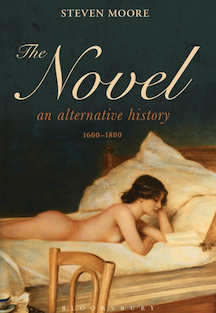Short-listed for the 2014 Phi Beta Kappa Christian Gauss Award
By Katy Sternberger
While not exactly light reading, literary historian Steven Moore’s The Novel: An Alternative History 1600–1800 traces the development of the novel in an effective and straightforward manner. Preceded by Moore’s first volume, in which he discusses the beginnings of fiction starting with ancient Egypt, this second volume focuses on the ways fiction flourished across two centuries. Moore considers more than 400 novels from around the world, paying particular attention to the obscure works of the period, for without the minor novels, we would not understand how the classics revolutionized our ideas of fiction.
Moore transitions seamlessly from one topic to another, despite his broad subject matter. He analyzes the European novel (covering Spanish, German, and Latin books), the French novel, the Eastern novel (covering Chinese, Korean, Japanese, Tibetan, Persian, and Indian books), the English novel, and the American novel. In addition to providing engaging plot summaries, he comments on how novelists experimented with and sought to perfect many different genres, including the Spanish picaresque, the German bildungsroman, the Chinese scholarly novel, and the nouvelle historique, dominated by Frenchwomen.
Beginning with an evaluation of Miguel de Cervantes’ Don Quixote, Moore shows how the Spanish novel set the stage for early modern fiction. He calls Don Quixote the “first modern novel…in the sense that it marks the transition from the medieval worldview (unscientific, faith-based, Ptolemaic, tradition-bound, authoritarian, certain, static) to the modern.” This novel, in its day, was an innovative example of metafiction, where an author intentionally refers to fiction within the fiction. Even as Don Quixote blurs the lines between reality and madness in a post-medieval world of uncertainty, he comments on what a good novel should and should not be.
Latin fiction and Eastern fiction were especially obscure during the early modern period. Indeed, Eastern novels have remained largely untranslated. Although Japanese authors had thrived during the formative years of the novel, writing hundreds of books between the tenth and fourteenth centuries, fiction in the East was a “stagnant art” up until the twentieth century. Meanwhile, novelists chose to write in Latin in order to disguise heretical or pornographic issues, or if they wanted their works to maintain a scholarly tone, Moore explains.
Women novelists of the seventeenth century, though still not widely documented today, pioneered works on feminism. For example, María de Zayas, who wrote during the Spanish Golden Age, used female protagonists to rail against patriarchal society. Moore says that she was responsible for “crashing the men’s club of Spanish fiction” and paved the way for future women writers, or, in her words, “Homers in skirts and petticoats or Virgils wearing a chignon.” Marie-Madeleine de Lafayette of France, noted for one of the earliest examples of the historical novel, was another female author who commented on the “affairs of the nation” through her fiction.
The Novel, an encyclopedia of fiction, is an argument to read the unexpected, the novels long passed by. As Moore says, “The novel settled into a norm during this early modern period, and as a result, this volume examines more ‘normal’ novels than the previous one did, all the better to contrast and appreciate the deviations from the norm.” These “deviations from the norm” are important in helping us understand the history and culture of society during a different era. For a checklist of uncommon novels to read, simply refer to the chronological index of novels discussed at the back of the book.
Katy Sternberger (ΦBK, University of New Hampshire, 2012) is a writer, editor, and researcher. After graduating from the English/journalism program at the University of New Hampshire, she is now pursuing her master’s degree in archives management at Simmons College.




